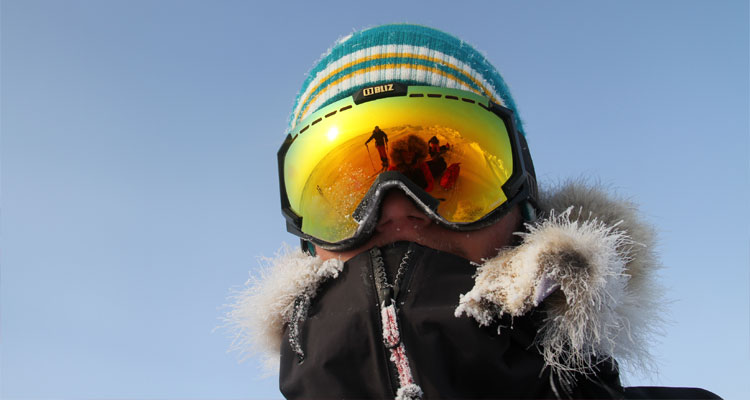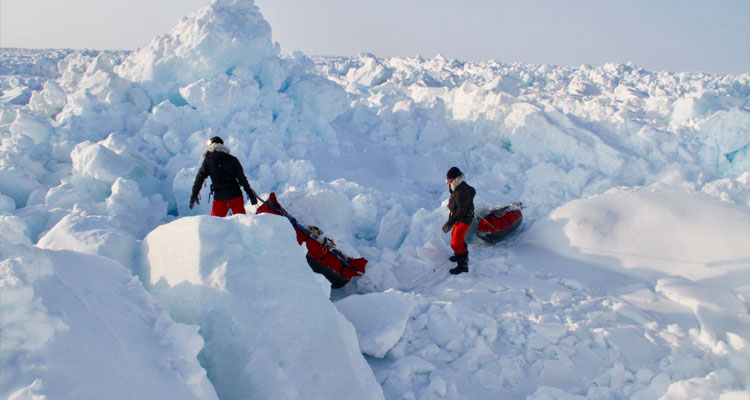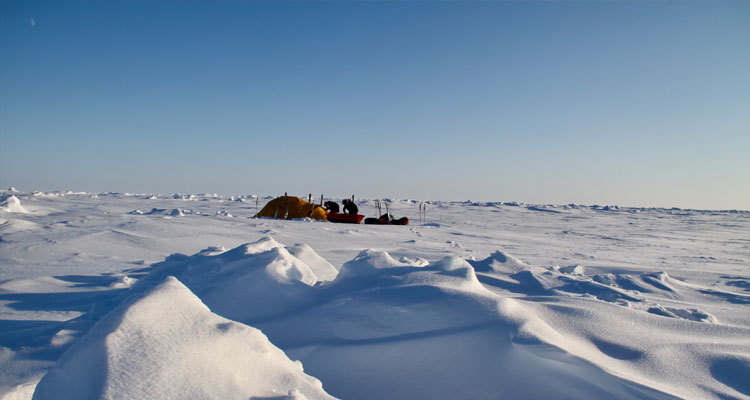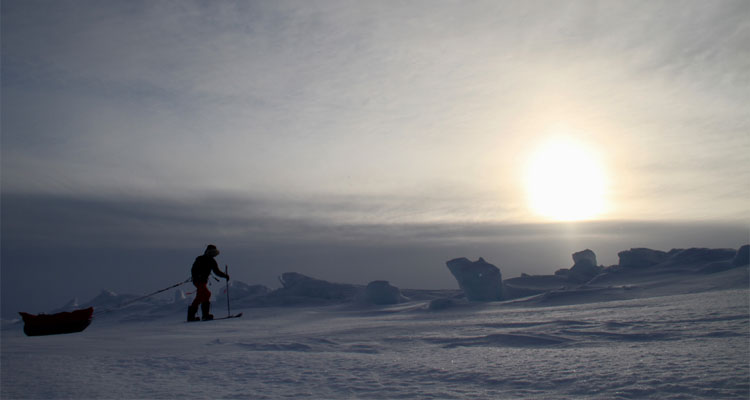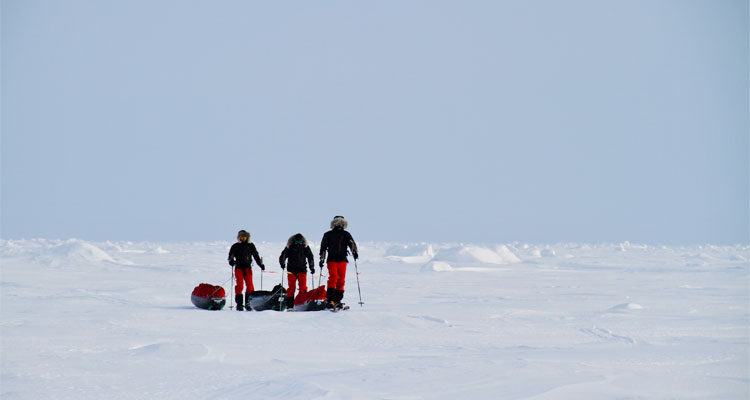North Pole Expedition
As we touched down in Spitsbergen for our arctic training, the reality really hit me. This place felt remote, and yet in just a few days’ time we would fly another 1,800km north to the Russian drift station Barneo. The temperature in this remote frontier town, well inside the Arctic circle, was fifteen below zero and yet that would be comparatively tropical to the temperatures of minus forty we would experience once we began our expedition.
My brother, father and I had always been keen to go the Arctic, excited by its remoteness – only thirty people a year reach the North Pole on foot (compared to about 500 people who summit Everest annually) and having a fascination with arctic landscapes from reading accounts of Amundsen’s expeditions. It’s also getting harder: global warming fears mean some believe it may soon become impossible to reach the North Pole on foot. After some research we made contact with a Belgium polar explorer called Dixie Dansercoer.
We first met Dixie in a Pret-A-Manger on Cannon Street. It seemed totally bizarre to be discussing everything from down-jacket requirements to polar bear attack strategies while hundreds of commuters rushed around grabbing their morning coffee. After some discussion back at home and, of course, reassuring my mother that the chances of a polar bear attack were minimal, we confirmed the expedition start date. The North Pole ice cap melts and refreezes every year so we were limited to a short weather window in mid-April. The expedition would start with 3 days’ arctic training in Spitsbergen learning to camp in sub-zero conditions and, of course, learning to pull the sledges on cross country skis.
Longyearbyen, the only town on the island of Spitsbergen, was to be our base. We would ‘man haul’ sledges with all our kit for about 120km. The sledges were awkward fibreglass structures and as soon as you began piling in all the kit we would need for our expedition, (food, cooking equipment, clothing, sleeping bags, tents, flares and a rifle) they became very heavy and tricky to handle on anything other than a flat surface. We worked late into the evening to pack and repack them for best balance.
The next morning, we left Longyearbyen on skis, pulling our sledges behind us to begin our arctic training. To start with, we trekked across the frozen sea inlet. This seemed fairly easy and once in the rhythm one could cover quite some ground. However, the energy and excitement wore thin after a few hours and then we settled into the ‘polar plod’ – a slow but steady pace.
After hours of trekking we set up camp. The cold had sapped all our energy and even doing the most menial tasks such as lighting the stove or putting the tent poles in seemed to take much longer than usual. Those few days were tough, constantly preparing for different situations from what happens if your sledge falls through the ice to polar bear attacks. We made hundreds of mistakes, basic things that made little difference in Spitsbergen but could end the expedition when we headed further North, such as touching any metal with bare skin which would be uncomfortable in Spitsbergen but on the ice cap at extreme temperatures the frozen metal would burn your skin.
Upon completion of the polar training we felt ready to go. However, Barneo was not ready. Each year the Russians build a runway on the polar cap 1 or 2 degrees from the Pole for scientific research purposes. It lasts a maximum of 8 weeks before the ice melts and the runway melts into the ocean below. This year, they were having huge problems because of warmer weather (didn’t feel like it) and turbulence in the Arctic Sea (due to El Niño and climate change). When they built an ice runway to take the ’plane, it would crack and become unusable.
Finally, word came that our ’plane could fly, but on the drive to the airport we were told the new runway had cracked as well, so we were back to town to continue waiting. Longyearbyen is a great place for two or three days but it wasn’t until the tenth day we were finally able to leave, by which time we had seen and explored everything and were pretty close to becoming tour guides ourselves.
Skidding and bouncing along the runway we arrived in Barneo with an outside temperature of -40C. After a quick turnout, we were in an old military helicopter flying to our drop-off point from which we would begin our attempt to the North Pole. The helicopter drops onto the ice, engines still going, and in the noise and the whirling ice crystals, we were turned out.
Once the snow settled, and the whump-whump of the helicopter’s propellors grew weaker, I looked around knowing there were just the four of us and then literally nothing but ice and snow for hundreds of miles in every direction. The sun was still out and the sky and snow were so bright.
What struck me first was that it wasn’t flat, I had imagined it would be reasonably level with the odd ice block stuck up here and there. However, instead there was a jumble of ice blocks some the size of the sledges, others the size of a house. Then the cold hit me. It was quite unlike normal cold – much harsher and drier. It hurt to breathe, it stung my face but I knew it wasn’t going to go away – I couldn’t simply retire back to the bar in Longyearbyen. I had to make do and live with it because for the next five days this was going to be the warmest I got.
Making camp that first night was entertaining, exciting and sleep came quickly. However, when we woke up the next day with a full day of trekking ahead it seemed bleak, and the weather was grey and windy, making the cold feel worse. Getting going was a real team effort as we broke camp and headed north. One of the things I found hard about trekking was the landscape didn’t change and the sun didn’t move in the sky so time was meaningless. It gave the impression we were never moving forward and were covering no ground at all – but in fact we were making good progress. Furthermore, at each ‘compression zone’ – an area where two ice flows have pushed together and pushed the ice up – we would have to pull the sledges through these cracks and broken ground which could be up to a kilometre wide and between 2 and 10 metres deep.
After each day’s trekking, doing even simple tasks such as cooking or setting up the tent was really hard. We would encourage each other or help out when someone was too tired.
Reaching the Pole itself was both incredible but also a bit of an anti-climax. Because the polar ice cap moves constantly the actual point of the Pole is not marked by anything. We reached a huge compression zone and knew from the GPS it was somewhere inside. So after unhitching our sledges in the general vicinity, we ran around with our GPSs out looking like children on an Easter egg hunt all desperate to find the exact point of the North Pole. After ten minutes or so of looking we found it and took some photos, drank whisky and congratulated each other on making it – we were the first people to reach the North Pole on foot in 2016.
While our expedition was an amazing experience and tough at times it only lasted five days and we had each other to keep ourselves going, to help each other out from forcing each other to eat to replenish energy, to working together to get our sledges through the toughest of the compression zones. Henry Worsley was by himself, he had no one to help push him along and help him out in the toughest moments and his expedition lasted 69 days. I can’t imagine how hard it must have been to keep going and push on, to always have the energy at the end of each day to set up camp and the loneliness of being in a polar landscape with no one to help if anything goes wrong. Worsley was a great inspiration to me after completing our expedition. I have the utmost respect for him, I am not sure I would have had the drive to go alone for our trip let alone for 900 miles?
Henry Macpherson (Cobham 13)



